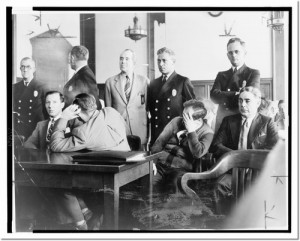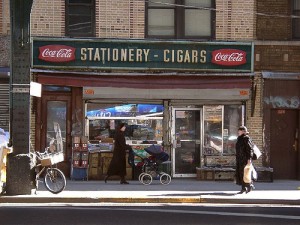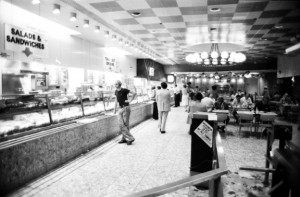Benjamin “Chippy” Weiner, a member of Lepke Buchalter’s Murder, Inc. kill squad, was shot to death in his Lower East Side apartment on Jan, 13, 1948. Weiner was home with his baby son, Louis. Knock on the door. Weiner, in silk pajamas, opened the door. Riddled with five bullets. As he lay on the floor, gushing blood, he said: “Take care of the baby, take care of the kid.” There are many mysterious aspects about the killing. Police said that Chippy owed loan shark Willie “Farby” Rosenberg $500 and wouldn’t pay, so Rosenberg hired mafia hitman Santo Bretagna. He killed Chippy. Both Rosenberg and Bretagne were convicted of the crime and died on the Sing Sing electric chair. HG still finds this strange nearly 70 years later. As my late, beloved father, Hershele Zvi Freeman, put it when he first heard of Chippy’s killing: “Nahrishkeit (foolishness). Killing Chippy doesn’t get the $500 back. Doesn’t put any kasha on the table. And, the cops are looking for the murderers. Lots of luck in getting away, schmucks.” Another mystery. Chippy’s wife, Sylvia, left the apartment before the murder. Said she was going for a walk and would buy cigarettes. Very cold night for a walk. She didn’t return for two hours, long after the murder. There was $765 in a mesh purse in her bedroom. Said she had no idea where the money came from. Asked about Chippy’s employment, she said he worked for a knitwear company. Not true in 1948; however, Chippy worked briefly, in 1946, as a shipping clerk for Brownie Knitting Mills, the company founded by HG’s uncle, Philip, and his wife, Marie. After they retired, the company was led by their son, Sol Freeman. HG’s father was in charge of sweater repairs, stock and shipping. Manufacturing was done in Pennsylvania. While an employee at Brownie, Chippy admired HG’s father. Hershele did not reciprocate. HG was friendly with Chippy when HG worked at Brownie during the hot summer. Hershele warned: “Chippeh (that’s how he pronounced it in his Yiddish-English accent) bist ah trumbenick (is a scoundrel). Don’t get friendly. You could be in the wrong place at the wrong time.” HG did not heed the advice. Would join Chippy for after work beers and listen with delight to Chippy’s stories about his variegated love life. Chippy and mobster Philip “Little Farvel” Kovelick were rivals for the romantic affections of a woman known as “The Red Rose of Williamsburg”. She was later indicted for the murder of Ruby ‘The Mock” Shapiro but dismissed for “lack of evidence.” The Judge described her as a “vile murderess.” Chippy married her daughter. “Little’ Farvel”, many years later, turned up dead in a steel drum in Florida. There was another Brooklyn gangster known as “Little Farvel”, Philip Cohen, a heroin smuggler. (Farvel is a Jewish egg pasta shaped like a tiny shell). HG has wondered what happened to Louis, Chippy’s baby son. There’s a photo taken a few days later showing the happy little fellow in the arms of a middle-aged woman identified as Lottie Burchess. Is she “The Red Rose? Did she adopt the kid? No answers. The mystery isn’t solved.
The “Chippy” Mystery
September 1st, 2017 § 6 comments § permalink
Brunzville AKA Brownsville
June 1st, 2015 § 2 comments § permalink
HG grew up in a Yiddish-speaking home. There was English, heavily accented English. It wasn’t until HG began elementary school that he learned the proper pronunciation of many words. HG accompanied Mom on bargain seeking forays to busy Bethkit Avenue in the East Bronx. Much later, HG discovered the street was pronounced BATH GATE Avenue (As in the Doctorow book, Billy Bathgate, the basis of the Dustin Hoffman-Bruce Willis film). Similarly, HG thought the far off section of Brooklyn where Mom’s relatives lived was Brunzville. Yes, Brownsville. Little HG enjoyed visits to Brownsville. HG’s cousins showed HG all the local sights: The candy store that was the hangout of Abe “Kid Twist” Reles, “Pittsburgh Phil” Strauss, “Tick Tock” Tannenbaum and other members of the lethal “Murder, Inc.” crew (These bad guys all wore natty wide brimmed fedoras, HG observed); the gym where Al “Bummy” Davis, “Schoolboy” Friedkin, Morrie Reif and all the other Jewish fighters trained; Pitkin Avenue with its movie theaters and Wyona Street with pushcarts and delicatessens. That Jewish enclave, settled by immigrants fleeing the Lower East Side, produced more than killers and prize fighters: Many show business stars (Danny Kaye and Shelley Winters among others); literary lights (Alfred Kazin); doctors, lawyers, Nobel Prize winners. For many years, Brownsville has been an African-American ghetto with few redeeming features. Mike Tyson is probably its most prominent alumnus. Mayor DeBlasio has promised new housing, policing, etc. for Brownsville. HG is hopeful this will mean a better life and future for Brownsville’s citizens. They deserve it.
The Ice Pick Cometh
September 11th, 2012 § 1 comment § permalink
When HG was a little lad during the Great Depression, the HG family of four (and sometimes five) spent summers in a Rockaway Beach boarding house. Two rooms (a kitchen/”dinette” and bedroom connected by a foyer. Mom and Pop slept in the bedroom. Sister slept in the foyer. HG slept on the kitchen floor. When brother occasionally joined the family, the kitchen table was shoved to a side and he joined HG on the kitchen floor. The rudimentary sleeping pads were rolled up in the morning and stored under the parental bed. Toilet was in the hall outside the apartment and was shared with another family. The arrangement encouraged alertness. Showers were in the basement of the boarding house and the water had two temperatures — cold and very cold. The summer season began July 1 and ended the day after Labor Day. Rent: $25 for the season. Did HG (or any of the other family members) feel deprived because of the crowding and primitive facilities? No. It was heaven. Life was lived (during the day) on the beach and in the sea and (at night) on the boardwalk cooled by salt air breezes. HG’s father commuted to the hot city and (rain or shine) upon his return spent an hour being refreshed in the Rockaway surf. The kitchen had no refrigerator. It had an ice box (serviced by a muscular Italian ice man named Vito). There was a basin beneath the ice box to contain the melting ice and it was little HG’s responsibility to make sure the basin was emptied before it could overflow. HG was dedicated to that task. As a reward, HG could use the ice pick to chip a bit of ice for a cooling treat. HG’s Mom would often chip some chunks of ice to put in her bowls of pink, cold beet borscht (best cold summer soup in HG’s long culinary experience). The ice pick got a lot of use. During that same time period ice picks were being used for lethal purposes by the Murder, Inc. killers from Brooklyn’s Brownsville neighborhoods. The renowned Jewish assassin, “Pittsburgh Phil” Strauss, would plunge an ice pick into his victim’s ear or temple. He was so deft that many medical examiners assumed the victim died of a cerebral haemorrhage. According to a recent New York Times story, the ice pick (after a decades long absence) has reemerged as a an anti-social utensil. It is now a weapon of choice for many Bronx street gangs. Obviously, these thugs have an affection for retro artifacts.
The Candy Store
August 20th, 2012 § 1 comment § permalink
New York used to be a city full of candy stores and cigar stores. The classic New York candy store carried regional NYC treats (Little Chunkies, Goldenberg’s Peanut Chews and Joyva Halvah) in addition to the national candy bar brands like Hershey, Nestle, Mars, etc.. It usually had a soda fountain dispensing egg creams, glasses of seltzer (“two cents plain”), milk shakes, “malteds” and simple sandwiches and coffee. It also sold cheap toys and some stationery items (“school supplies”). Cigarettes and cigars, naturally. There was a rack of magazines and comics and outside there was a newsstand. Well into the 50’s New York had four afternoon newspapers (Post, Sun, World-Telegram, Journal-American) and four morning papers (Times, Herald-Tribune, News, Mirror) and for a time, the super-liberal PM (later re-named The Compass). There were loads of foreign language papers: The Forward, Day, Morning Journal, Il Progreso, La Prensa, Aufbau, etc.). There were even two communist newspapers, The Worker (in English) and Freiheit (in Yiddish). After dinner, men strolled to the neighborhood candy store to get the early edition of the News and Mirror. The News was the better, sharper paper but the Mirror had the Walter Winchell column and the latest racing results (a necessity for the inveterate horse player).
The candy store was the hangout of bookmakers, gamblers and money lenders (known as “Shys”). Except in the Times Square neighborhood (where there were no candy stores), New York’s cigar stores didn’t attract quite the same sporting element. Candy stores flourished in Jewish neighborhoods. The tough Brownsville neighborhood of Brooklyn was a predominantly Jewish neighborhood. The lethal Murder, Inc. flourished there. It was typical that the Jewish contract killers (“Kid Twist”, “Pittsurgh Phil”. Albert “Tick Tock” Tennenbaum, etc.) didn’t hangout at bars. Their hangout was a candy store called Midnight Roses’s. When little HG visited his Brownsville cousins they were pointed out as neighborhood celebrities. The Brownsville prize fighters — Al Davis, Morrie Reif, Schoolboy Friedkin, etc. — had their own candy store gathering place.
The Age of the Great NY Cafeterias
March 4th, 2012 § 32 comments § permalink
Fast food franchise junk, escalating real estate prices, changing customs. These all knocked out the great New York cafeterias that fed old schmoozers, loquacious intellectuals, cab drivers, garment center workers, students, artists — everybody, in fact. In terms of cuisine, the best was Dubrow’s. There were three: one in the garment center (this was where HG dined before Knicks games at Madison Square Garden); one on Eastern Parkway in Brooklyn (where HG dined after watching Joe Klein, Floyd Paterson, Joey Giardello and other fighters at the Eastern Parkway Arena); another branch on Brooklyn’s Kings Highway (too quiet and staid for HG). All were decorated in high, post-Depression, “modernist” style with plenty of mirrored walls and pale, glistening wood. The garment center Dubrow’s (on Seventh Avenue in the 30’s) was a madhouse during weekday lunch hours. The wonder was how the cloak-and-suiters and skilled workers could eat so much and talk so much at the same time. The Eastern Parkway Dubrow’s was favored by Jewish bookmakers, horse players, gamblers, loan sharks and the last remnants of Brownsville’s Murder Inc. and associated Lepke mob. These were guys who favored expensive hats, sharp suits (by Brooklyn’s Abe Stark) and big cigars. A guy not wearing a suit, tie and hat was a “bum,” despised by all. By 1985 all the Dubrow’s were gone.
The Belmore Cafeteria on 28th Street and Park Avenue South (Fourth Avenue before the fancy name change) was a 24-hour-a-day place favored by cab drivers. Martin Scorcese’s movie “Taxi Driver” burnished its fame. The scenes between Robert DeNiro and Peter Boyle take place in front of The Belmore. Phil Siegel ran The Belmore for decades and never changed its motto: “New York’s Most Fabulous Restaurant.” Like Dubrow’s, it had plenty of Jewish and Eastern European specialties but there were many eclectic culinary surprises as well. It was always busy. At its peak, The Belmore fed some 5.000 New Yorkers every weekday. Siegel sold the cafeteria and its corner site in 1981 to developers of a “sliver” condo development.
A sad and quiet cafeteria was The Senate on Broadway and 96th. There were lots of tattoos there. No, not the multi-colored skin-scapes favored by today’s hipsters. These were the grim number tattoos of Holocaust survivors, men and women who conversed quietly over endless cups of tea. I.B. Singer, the Nobel Prize-winning Yiddish writer, was often there eating tuna salad (he also favored The Eclair,a middle European pastry shop and restaurant on W.72nd). Singer based many of his stories on the aged folks he met there — people whose stories bordered on the supernatural. There were two other groups at The Senate: junkies and hookers. The strung out junkies ate trays of the sweetest cakes they could find The hard working hookers favored more robust fare. They ate fast. Their demanding business agents didn’t like them taking too much time off.
The cafeterias of New York have vanished. Mickey Dee and the landlords have won.
“Little Farvel'” — Bad Guy. Good Food.
August 13th, 2011 § 0 comments § permalink
“Little Farvel” (AKA Phillip Kovelick) was a Jewish gangster and Murder Inc. member from the Brooklyn neighborhood of Williamsburg . This was long before the area became a favored site of hipsters and cool eateries. This bad guy had the distinction of being named for one of HG’s favorite foods — egg barley called “farvel” in Yiddish.
“Little Farvel” ended his career enclosed, very dead, in a steel drum in Florida. One of Little Farvel’s rivals, in crime and romance, was another Jewish hood, Benjamin “Chippy” Weiner. Chippy was once employed by the HG family firm (sweater manufacturing) where he much admired HG’s father. HG’s father did nor reciprocate the affection. HG liked Chippy and was admonished by his father who pointed to Chippy as a “shandeh” (a shame or disgrace). As predicted by HG’s dad, The Chipster came to a bad end. He did not pay a loan shark named “Farby”, another unsavory Jewish gent, a borrowed 500 bucks. Farby didn’t treat this as a trivial matter. Instead, he employed a very bad Mafia soldier named Santo Bretagna to chastise Chippy. Santo chastised him to death and clumsy Farby and Bretagna got the Sing Sing electric chair for their murderous misdeed.
Another bad guy with a great food nickname was a distant relative of HG’s late cousin, Gladys F. He was dubbed “Potatoes” and was affiliated with Chicago’s Capone mob. But, in HG’s opinion the winner of the Jewish bad guy nickname contest was the late Moses “Moey Dimples” Wolinsky. Runner up: The late Allie “Tick Tock” Tannenbaum.
Wait! What about that egg barley we were discussing? Enough gangster digression, let’s get back to food. Here’s the way HG likes his “farvel”: Toast a cup of egg barley (Manischewitz is a good brand) in some vegetable oil. Add a cup (or more) of hot chicken stock until it is absorbed and the egg barley is tender. Serve it topped with onions and mushrooms sauteed in butter. And, of course, a dollop of sour cream. Or, eliminate the sour cream and serve it as a side with beef stew — it has the same effect as spetzle or buttered egg noodles.
Nosh on that, then raise your wine glass in a joyous toast to those colorfully named bad guys of yesteryear.




